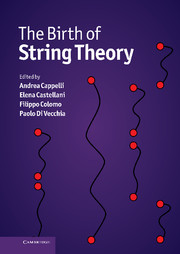Book contents
- Frontmatter
- Contents
- List of contributors
- Photographs of contributors
- Preface
- Abbreviations and acronyms
- Part I Overview
- EARLY STRING THEORY
- Part II The prehistory: the analytic S-matrix
- Part III The Dual Resonance Model
- 10 Introduction to Part III
- 11 From the S-matrix to string theory
- 12 Reminiscence on the birth of string theory
- 13 Personal recollections
- 15 Early string theory at Fermilab and Rutgers
- 15 Dual amplitudes in higher dimensions: a personal view
- 16 Personal recollections on dual models
- 17 Remembering the ‘supergroup’ collaboration
- 18 The ‘3-Reggeon vertex’
- Part IV The string
- TOWARDS MODERN STRING THEORY
- Part V Beyond the bosonic string
- Part VI The superstring
- Part VII Preparing the string renaissance
- Appendix A Theoretical tools of the Sixties
- Appendix B The Veneziano amplitude
- Appendix C From the string action to the Dual Resonance Model
- Appendix D World-sheet and target-space supersymmetry
- Appendix E The field theory limit
- Index
18 - The ‘3-Reggeon vertex’
from Part III - The Dual Resonance Model
Published online by Cambridge University Press: 05 May 2012
- Frontmatter
- Contents
- List of contributors
- Photographs of contributors
- Preface
- Abbreviations and acronyms
- Part I Overview
- EARLY STRING THEORY
- Part II The prehistory: the analytic S-matrix
- Part III The Dual Resonance Model
- 10 Introduction to Part III
- 11 From the S-matrix to string theory
- 12 Reminiscence on the birth of string theory
- 13 Personal recollections
- 15 Early string theory at Fermilab and Rutgers
- 15 Dual amplitudes in higher dimensions: a personal view
- 16 Personal recollections on dual models
- 17 Remembering the ‘supergroup’ collaboration
- 18 The ‘3-Reggeon vertex’
- Part IV The string
- TOWARDS MODERN STRING THEORY
- Part V Beyond the bosonic string
- Part VI The superstring
- Part VII Preparing the string renaissance
- Appendix A Theoretical tools of the Sixties
- Appendix B The Veneziano amplitude
- Appendix C From the string action to the Dual Resonance Model
- Appendix D World-sheet and target-space supersymmetry
- Appendix E The field theory limit
- Index
Summary
The year 1968 was quite remarkable also in science: it was the year of the Veneziano formula, a real breakthrough towards new horizons in theoretical physics.
In July 1968 in Turin we heard a seminar by Gabriele Veneziano who came to submit his beta function amplitude to the attention of Sergio Fubini, an opinion leader in the theory of strong interactions after his works on current algebra (the p→∞ method, with G. Furlan) and on superconvergence (with V. De Alfaro, G. Furlan and C. Rossetti). Fubini encouraged Veneziano to publish his paper, which soon appeared [Ven68] in Nuovo Cimento (at that time the most important journal in high energy physics in Europe) and invited the young physicists in Turin to look at this promising model.
Actually my interest increased when the generalization of the Veneziano amplitude to N points was proposed by K. Bardakci, H. Ruegg, M. A. Virasoro, H.M. Chan, S. T. Tsou, C. J. Goebel, B. Sakita, Z. Koba and H. B. Nielsen. I was fascinated by the elegance of the ‘duality rules’: the poles in the various channels were exhibited by simple changes of integration variables, dictated by (elementary) geometry.
My enthusiasm burst in the spring of 1969, when Miguel Virasoro gave a seminar in Turin on his work with Keiji Kikkawa and Bunji Sakita [KSV69]: up to some (crucial) factors, the structure of the multiloop amplitudes was simply dictated by consistency with the duality rules.
- Type
- Chapter
- Information
- The Birth of String Theory , pp. 214 - 218Publisher: Cambridge University PressPrint publication year: 2012
- 2
- Cited by



